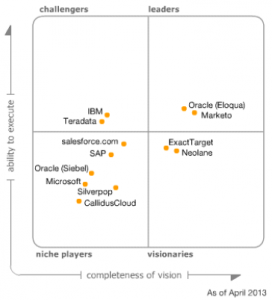Marketing Automation Can Increase the Value of Your Business
 Executives have a lot to do. Plenty of people who are building businesses are grooming them for sale – and who can blame anyone for that? Businesses with tremendous growth potential are true cash cows, ready to make years of steady income for the right buyer.
Executives have a lot to do. Plenty of people who are building businesses are grooming them for sale – and who can blame anyone for that? Businesses with tremendous growth potential are true cash cows, ready to make years of steady income for the right buyer.
In selling a small to medium sized business, owners and investors know they need to make the business look as profitable as possible to potential buyers. For businesses who are selling service instead of retail, account managers and the sales team already face difficult divisions. Sales folks who are driven by commission often over-promise, so by the time accounts get to analysts there’s already a problem.
This problem can be exacerbated by executives who are hard-driving their sales staff without follow-up on the quality of work environment and account performance with regard to the account service teams. If this sounds like your situation, watch your cancellation numbers – more often than not, overselling without account teams to handle the load can result in tons of dropped clients and bad reviews.
Enter Marketing Automation…
If you’re grooming your business for sale and you find that in your business, “one hand doesn’t know what the other is doing,” marketing automation could be the key to streamlining communications between different parts of your business – and as an overall result, your customers’ experiences with you.
With a marketing automation system in place – and the support to cover any process questions you need addressed – you can rest assured that the start to finish sales and performance processes for your business are handled.
Marketing automation allows sales people to better quality leads, put a system into place that is hands-off for following up on leads, keep better track of customer communication and offer a more streamlined transition to account management.
Marketing automation allows leads that haven’t converted to stay in your funnel more efficiently. Lead scoring allows you and your sales teams to communicate in the most effective way with clients who haven’t yet made a commitment to you.
Marketing automation makes setting up and performing work on new accounts easier for your account analysts. Email management, reporting and handling overall marketing functions for your business can become a more streamlined process with the right marketing automation tools at hand.
Making the Ultimate Sale
A potential investor or buyer for your business is going to want to see not just increased sales numbers and great profitability/growth potential. They’ll want to know you have a great process in place for ensuring future success and a great investment. Marketing automation tools placed properly and utilized by your team can actually increase the value of your business. When you can demonstrate that the future of determining the value of leads and acting on that value is secure, you’re showing investors they can trust they’re making a good purchase.
Don’t wait until the selling process starts to get marketing automation in place – make sure your employees are able to use this technology now! Lead Liaison is happy to help discuss your marketing and selling needs to address how marketing automation can make your business more valuable.











